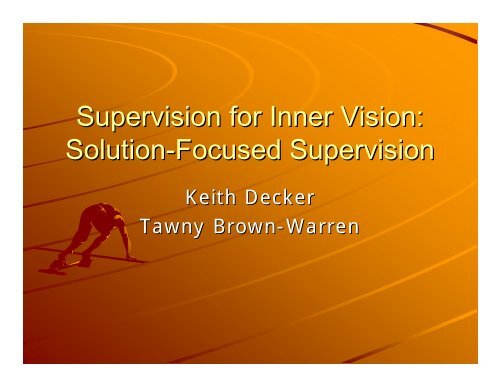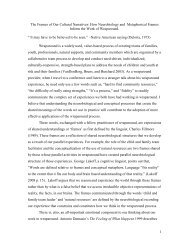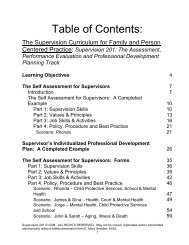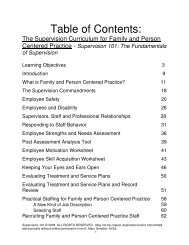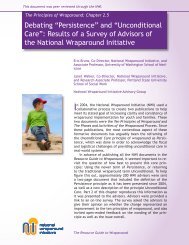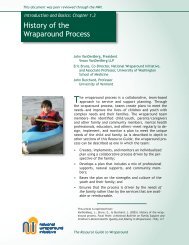Supervision for Inner Vision: Solution-Focused Supervision
Supervision for Inner Vision: Solution-Focused Supervision
Supervision for Inner Vision: Solution-Focused Supervision
You also want an ePaper? Increase the reach of your titles
YUMPU automatically turns print PDFs into web optimized ePapers that Google loves.
<strong>Supervision</strong> <strong>for</strong> <strong>Inner</strong> <strong>Vision</strong>:<br />
<strong>Solution</strong>-<strong>Focused</strong> <strong>Supervision</strong><br />
Keith Decker<br />
Tawny Brown-Warren
Purpose of <strong>Supervision</strong><br />
Through supervision, we aim to both<br />
develop those basic capacities and<br />
competencies necessary <strong>for</strong> the job<br />
and<br />
facilitate the supervisees’ sense of inner<br />
direction and creativity – or inner vision
SF SUPERVISION<br />
WHAT IS IT?<br />
Collaborative, curious and respectful<br />
Flexible<br />
Parallel process<br />
Based on the same premises as<br />
SFBT
SF SUPERVISION<br />
“The knowledge of what supervisees do<br />
correctly in supervision is more important<br />
to the overall development of personal<br />
competency and the well-being of their<br />
clients than is a continual focus on clinical<br />
mistakes. In an unlimited universe there<br />
are more things clinicians do not know<br />
about therapy than they can ever possibly<br />
know how to do correctly.” (Wetchler<br />
1990)
SF SUPERVISION PREMISES<br />
<strong>Solution</strong>-focused<br />
supervision, in parallel<br />
with therapeutic<br />
practice, is about<br />
collaborating in a<br />
partnership which<br />
pays attention to, and<br />
develops, the<br />
supervisee's interests,<br />
best intentions, and<br />
goals <strong>for</strong> their work<br />
(Table 1).
Table 1: A comparison between solution-focused therapy<br />
SF Therapy<br />
and solution-focused supervision.<br />
SF <strong>Supervision</strong><br />
Seeks to be helpful to the client<br />
in their agenda <strong>for</strong> therapy.<br />
Focuses on history of resources<br />
and strengths and the ‘solution<br />
story’ rather than the ‘problem<br />
story’.<br />
Pragmatic — helps the client<br />
notice what works — their good<br />
qualities, abilities in the face of<br />
difficulties, etc.<br />
Collaborates with the client on<br />
their agenda.<br />
Seeks to be helpful to the<br />
supervisee in their agenda<br />
<strong>for</strong> their work.<br />
Focuses on abilities,<br />
learning, and strengths that<br />
the supervisee’s s already has.<br />
Pragmatic - helps the<br />
supervisee’s s notice what<br />
works — their skills, abilities,<br />
creative ideas, etc. in the<br />
service of the client/patient.<br />
Collaborates with the<br />
supervisee’s s on their agenda<br />
<strong>for</strong> their work with<br />
clients/patients.
Table 1: A comparison between solution-focused therapy<br />
and solution-focused supervision, cont’d.<br />
SF Therapy<br />
Listens constructively <strong>for</strong><br />
client's unique strengths and<br />
resources.<br />
Invites client to talk about<br />
and develop details of their<br />
ideas of their preferred future.<br />
Uses scales and circular<br />
questioning to note and<br />
measure progress towards<br />
client's preferred future and<br />
goals<br />
Maintains professional<br />
boundaries of time, place,<br />
confidentiality and ethical<br />
practice; Strives <strong>for</strong> best<br />
therapeutic practice.<br />
SF <strong>Supervision</strong><br />
Listens constructively <strong>for</strong> the<br />
supervisee’s unique strengths<br />
and resources in order to aid<br />
clients and their practice<br />
generally.<br />
Invites and develops<br />
supervisee’s preferred future<br />
in terms of being as good a<br />
therapist as they can possibly<br />
be <strong>for</strong> this client, or all<br />
clients/patients, and in their<br />
working context.<br />
Uses scales and circular<br />
questioning to note and<br />
measure progress towards the<br />
supervisee’s best practice
SF SUPERVISION<br />
SUPERVISOR’S S STANCE<br />
Guru<br />
Gatekeeper<br />
Guide<br />
(Thomas, 2000)
SF SUPERVISION<br />
TECHNIQUES<br />
Miracle Questions<br />
Use scales to measure and<br />
develop progress<br />
Offer appropriate, evidenced<br />
compliments<br />
Goal Setting<br />
Identify Exceptions<br />
(Waskett,, 2006)<br />
Be future-oriented and<br />
assume competence
SF SUPERVISION TECHNIQUES<br />
Miracle questions –<br />
“If you were working better with this client and<br />
your current difficulties had been overcome, what<br />
would be the first signs <strong>for</strong> you that a miracle<br />
had happened?”*<br />
“What will be different about <strong>for</strong> you and/or your<br />
client when this is no longer a problem?”**<br />
**<br />
“If we were working at our optimum level (i.e. –<br />
the best supervision ever), what would that look<br />
like?** like **<br />
*(O’Connell & Jones, 1997)<br />
**<br />
**(Waskett,, 2006)
SF SUPERVISION TECHNIQUES<br />
Scaling - used in solution-focused supervision to<br />
develop answers to the miracle question, but it<br />
can also be used elsewhere during supervision.<br />
“On a scale of 0 to 10, 10 being your effectiveness with this<br />
client after the miracle and 0 the lowest it’s ever been,<br />
where would you say you are today?”<br />
• Where would you like to get to?<br />
• What would it look like when you got there?<br />
• What would be happening that’s not happening now?<br />
• What would have stopped happening?<br />
• What would need to happen <strong>for</strong> that to happen?<br />
• What would be the first thing you would do?<br />
• What would the client notice was different?<br />
• What would you need to remind yourself about?<br />
• If there were set backs how would you get back on track?<br />
(O’Connell & Jones, 1997).
SF SUPERVISION TECHNIQUES<br />
Scaling Questions–<br />
“On a scale of 1 to 10, where 1 is as worse as the<br />
problem can get, where would you say you are<br />
today?”<br />
“When you are close to moving to the next number,<br />
how will you know; what will be different about the<br />
way you handle that situation?”
SF SUPERVISION TECHNIQUES<br />
Scaling Questions–<br />
“Where 10 means our supervision today was as<br />
useful as it could have been, and 0 means not useful<br />
at all, where are we on that scale after our<br />
meeting?”<br />
“Ok, so what went well, or what was most useful in<br />
our conversation that made you choose that<br />
number?”<br />
“What would have to be different next time (what<br />
would we have to do differently) to move up one<br />
point from there?”<br />
(Waskett,, 2006)
SF SUPERVISION<br />
SCALING EXERCISE<br />
Get in pairs (“supervisee/supervisor(<br />
supervisee/supervisor”)<br />
“Supervisee” thinks of a practice situation they<br />
have been unhappy about/struggling with.<br />
Supervisor asks on a scale of 0-100<br />
(10=best possible client<br />
outcome):<br />
How far on the scale had the client come since first meeting<br />
w/ you?<br />
What would your client say about this?<br />
What might your client have said about how s/he has<br />
moved to that number; what has been helpful <strong>for</strong> him/her<br />
and what strengths were used to get there?<br />
What would you and your client say when life was<br />
significantly better? How is this happening now – even a<br />
little bit?<br />
Swap roles!
SF SUPERVISION<br />
EXCEPTIONS<br />
Exception questions:<br />
Help supervisees focus on those<br />
times when things went well - or at<br />
least not as badly.<br />
Prevent supervisees from ‘awfulising’<br />
Identify areas of competence
SF SUPERVISION<br />
Identifying Exceptions<br />
“Tell me about the times that you expect<br />
this problem, but it doesn’t t happen?”<br />
“How do you explain this, and what did<br />
you do to make it happen?”<br />
“When is the problem less frequent, or a<br />
little different from the problem you<br />
describe?”<br />
“When are you already doing a little of<br />
what you’d d like to be doing regarding this<br />
problem?”
SF SUPERVISION<br />
Making Exceptions Meaningful<br />
“How were you able to do that?”<br />
“What accounted <strong>for</strong> the change?”<br />
“What do you think the client noticed<br />
about the change?”<br />
“So you feel not much has improved<br />
since last week, what are you doing<br />
to keep it <strong>for</strong>m getting any worse?”
SF SUPERVISION<br />
LANGUAGE<br />
Pre-suppositional language - language<br />
which is future oriented and assumes<br />
competence.<br />
Pre-suppositional statements assume that<br />
there were times that progress was being<br />
made with the client. The supervisee is<br />
thus encouraged to think about examples<br />
when things were better.
SF SUPERVISION<br />
COMPLIMENTS<br />
Focus is on what the supervisee is<br />
doing well<br />
Provides encouragement and support<br />
Enables supervisee to use areas of<br />
competence to solve problems
SF SUPERVISION<br />
GOAL SETTING<br />
“One cannot hit a target without a<br />
target”<br />
Thomas (1996) suggests 3 month<br />
goals that are:<br />
Observable<br />
Measurable<br />
Verifiable
Keeping It <strong>Solution</strong>-<strong>Focused</strong><br />
<strong>Focused</strong>…<br />
What {job responsibilities} would be the<br />
most productive <strong>for</strong> us to focus on today?”<br />
“Tell me what would you like to get most<br />
out of meeting today?”<br />
“What aspect of your work has gotten<br />
better since we last met?”<br />
“Tell me the best thing you did with a<br />
client this week?”
Exercise –<br />
SF SUPERVISION<br />
“How To Interview <strong>for</strong> Client<br />
Strengths” (De Jong<br />
Jong & Miller, 1995)
“How To Interview <strong>for</strong> Client<br />
Strengths”<br />
What are some of the <strong>Solution</strong>-<strong>Focused</strong><br />
Techniques mentioned in this article?<br />
How could these be applied to supervision?<br />
Are you currently using any of these techniques?<br />
If so, which ones?<br />
If you are currently not using any techniques,<br />
which ones could you see yourself using?<br />
Are your CMs using any of these SF techniques?<br />
If so, which ones – and give examples, if<br />
possible.<br />
Do you disagree with assumptions or techniques<br />
of SF? If so, please explain.
“The branch will tell me how to<br />
carve it….each piece of wood has<br />
its own shape, which you must<br />
respect… in each branch lies a<br />
flute, my job is to find it”<br />
(Thomas, 1996).
SOLUTION FOCUSED SUPERVISION<br />
Resources<br />
Anderson H. and Swim S.,(1995) <strong>Supervision</strong> as Collaborative Conversation:<br />
Connecting the Voices of Supervisor and Supervisee. Journal of Systemic Therapies<br />
14 (2) pp1-13<br />
O'Connell B, Jones C. <strong>Solution</strong>-focused supervision. Counselling, , November 1997 pp 289-292<br />
292<br />
Thomas F.,(1994) <strong>Solution</strong> -Oriented <strong>Supervision</strong>: The Coaxing of Expertise. The<br />
Family Journal 2 (1) pp11-17<br />
Turnbull, J. and Turnbull, W. (2008, June 30). <strong>Solution</strong> <strong>Focused</strong> <strong>Supervision</strong>. . Accessed on<br />
August 14, 2008 from www.yorkshiresolutions.org.uk/download/05-05<br />
05-26supervision.ppt<br />
Waskett, C (2005): The Pluses of <strong>Solution</strong> <strong>Focused</strong> <strong>Supervision</strong>, in HCPJ, January 2005<br />
Wetchler J.L., (1990) <strong>Solution</strong> <strong>Focused</strong> <strong>Supervision</strong>. Family Therapy 17 (2) pp129-<br />
138<br />
White, M., & Epston, D. (1990) Narrative means to therapeutic ends. New<br />
York: Norton.


